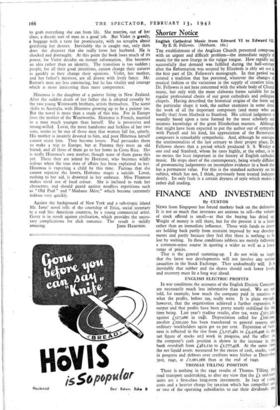Shorter Notice
English Cathedral Music from Edward VI to Edward VII, By E. H. Fellowes. (Methuen. i6s.) THE establishment of the Anglican Church presented composers with an urgent and difficult problem—the immediate supply el music for the new liturgy in the vulgar tongue. How rapidly and successfully that demand was fulfilled during the half-century after the Reformation was secured by Elizabeth is ably set out in the first part of Dr. Fellowes's monograph. In that period was created a tradition that has persisted, whatever the changes of musical fashion or the variations in the supply of creative talent Dr. Fellowes is not here concerned with the whole body of Church music, but only with the more elaborate forms suitable for the regular professional choirs of our great cathedrals and collegiate chapels. Having described the historical origins of the form and the particular shape it took, the author examines in some detail the work of all the important composers (and many who an hardly that) from Marbeck to Stanford. His critical judgement is soundly based upon a taste formed by the most scholarly and intimate knowledge of the great Elizabethan masters. Although that might have been expected to put the author out of sympathy with Purcell and his kind, his appreciation of the Restoration composers is remarkably sympathetic. And, although he consigns the sentimentalists of the last century to their proper place, Dr. Fellowes shows that a period which produced S. S. Wesley at one end and Stanford, whom he rates highly, at the other, is by no means the least important in the history of English cathedral music. He stops short of the contemporary, being wisely diffident of pronouncing judgements on incomplete evidence in a book that has a permanent value. For this is the standard authority on the subject, which has not, I think, previously been treated indepen- dently. Its only fault is a certain dryness of style which makes it rather dull reading.


























 Previous page
Previous page